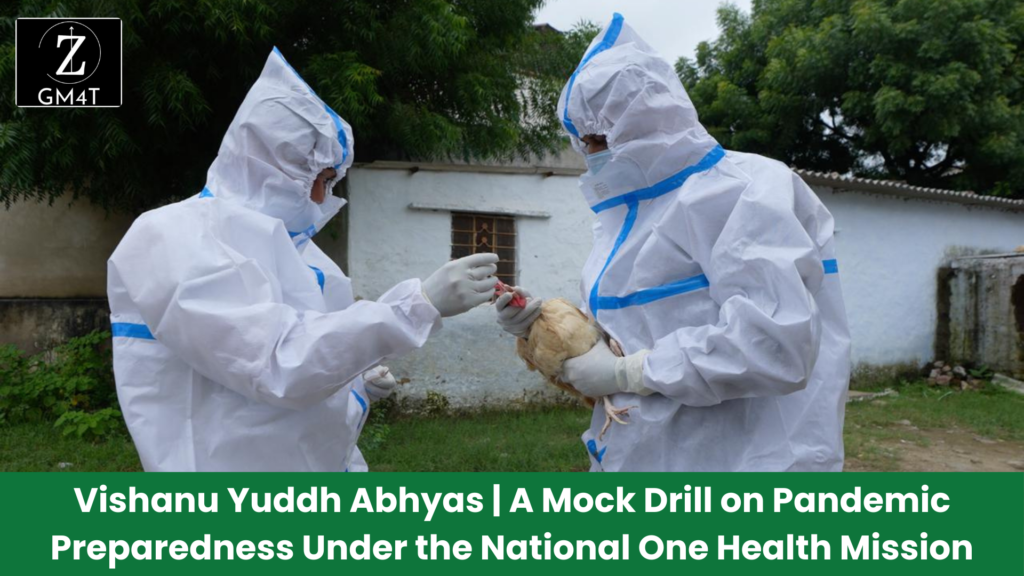
Discover – Vishanu Yuddh Abhyas | A Mock Drill on Pandemic Preparedness Under the National One Health Mission – In a world increasingly threatened by the risk of zoonotic diseases, cross-sectoral collaboration between human, animal, and environmental health sectors is crucial to preventing and managing outbreaks. Recognizing this, India conducted its first-ever comprehensive pandemic preparedness mock drill, Vishanu Yuddh Abhyas (Virus War Exercise), under the aegis of the National One Health Mission (NOHM). The exercise, held in Rajasthan’s Ajmer district from August 27 to August 31, 2024, served as a robust test of the country’s ability to respond to a zoonotic disease outbreak, bringing together experts from human health, animal husbandry, and wildlife sectors.
Mission Objectives and Structure
Vishanu Yuddh Abhyas aimed to evaluate the readiness of India’s National Joint Outbreak Response Team (NJORT) by simulating a zoonotic disease outbreak. The drill was structured into two critical components:
- Investigation and identification of the virus responsible for the outbreak.
- Actions initiated to control the spread across human, animal, and environmental populations.
This exercise was a landmark event for India’s One Health mission, involving diverse stakeholders such as the National Centre for Disease Control (NCDC), Indian Council of Medical Research (ICMR), Department of Animal Husbandry and Dairying (DAHD), and the Ministry of Environment, Forest, and Climate Change (MoEF&CC). Other key players included state authorities, district administration, and specialized labs like AIIMS Jodhpur BSL-3 Lab, one of India’s 19 National BSL-3 Network Laboratories.
The Role of One Health
The One Health approach, which emphasizes the interconnectedness of human, animal, and environmental health, is central to India’s pandemic preparedness strategy. The National One Health Mission envisions integrated disease surveillance and early warning systems that rely on cross-sectoral collaboration and advanced data analytics.
The Vishanu Yuddh Abhyas exercise was a practical demonstration of this approach. It showcased how shared surveillance data from sectors such as human health, animal husbandry, and wildlife can inform early detection and rapid response to emerging threats. By simulating real-world conditions, the mock drill underscored the importance of coordination across different government bodies and the use of sentinel-based environmental surveillance to detect pathogens in sources like sewage, vectors, and animal trade.
Key Components of the One Health Mission
- Integrated Disease Surveillance: NOHM integrates surveillance efforts from human, animal, and environmental sectors, focusing on diseases of zoonotic, transboundary, and epidemic/pandemic potential. This includes environmental surveillance, which offers cost-effective and sensitive approaches for disease detection.
- Robust Outbreak Response Mechanisms: NOHM aims to strengthen outbreak investigation mechanisms through the creation of Rapid Response Teams (RRTs) at the district level, linked to national and state-level response units. These teams are expected to function seamlessly across routine disease control programs and pandemic threat scenarios.
- Environmental Surveillance System: A critical aspect of One Health, environmental surveillance extends beyond traditional clinical data to include sentinel sites such as wildlife habitats, abattoirs, ports, and sewage systems. This approach enhances early detection, particularly for diseases targeted for elimination.
Critical Analysis: Strengths, Weaknesses, Opportunities, and Threats
The Vishanu Yuddh Abhyas mock drill highlighted several strengths of India’s One Health approach, particularly the emphasis on cross-sector collaboration and the integration of surveillance systems across human, animal, and environmental sectors. The drill demonstrated India’s growing capacity for rapid detection and response, using tools such as environmental surveillance and BSL-3 laboratories.
However, significant weaknesses persist. There remains a gap in interagency coordination, especially at the district level where resources are limited and communication between human, animal, and wildlife sectors is still evolving. The effective deployment of digital and environmental surveillance tools depends heavily on infrastructural support, which is unevenly distributed across India.
The opportunities presented by the One Health approach are vast. By strengthening cross-sectoral collaboration, India can enhance its preparedness not just for zoonotic diseases but also for emerging threats like antimicrobial resistance (AMR). With better resource allocation and continued investment in surveillance technologies, India has the potential to lead global efforts in pandemic preparedness. Yet, threats remain, especially in the form political will and resource constraints. The success of future pandemic response strategies will depend on how well India can address these challenges, especially in rural and underserved regions where zoonotic diseases often originate.
Read Also :-
- Scenario: Assessing Knowledge About Cervical Cancer Among Medical Students
- The Art of Writing Aims and Objectives in Research
- Crafting the Perfect Research Introduction: A Guide for Medical Researchers
- Mastering Protocol Writing for Medical Research
- The Art of Reviewing Literature
- Cross-Sectional Study Design: A Snapshot of Epidemiology
- How to Perform Statistical Tests in a Cross-Sectional Study: A Step-by-Step Guide
